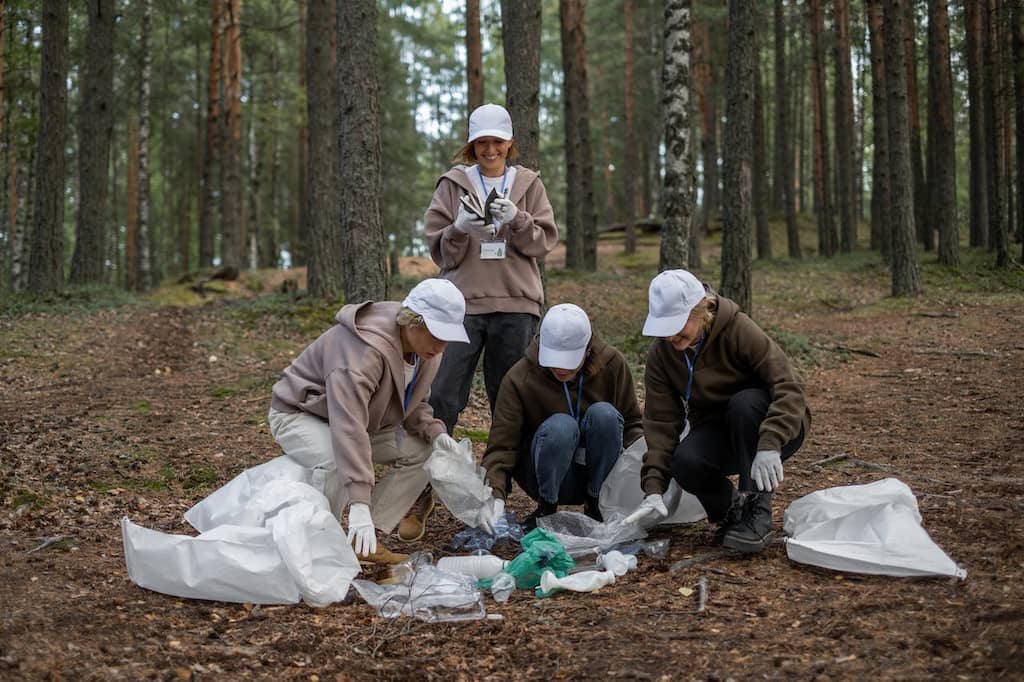In today’s digital age, remote work has become increasingly prevalent. While it offers flexibility and convenience, it can also present challenges in team cohesion and collaboration. Remote team-building activities (or virtual team-building exercises) can bridge the virtual gap and boost team morale.
If you’re looking to enhance your team’s efficiency, consider using a free time card calculator to track productivity. Here, we’ll explore the world of remote collaboration and team building. From the challenges it addresses to engaging activities that will help your remote team thrive, connect, and excel in a virtual workspace.
Types of Remote Team-Building Activities
Remote team-building activities come in a variety of forms, each serving a unique purpose in strengthening bonds and enhancing teamwork. Here we explore the different categories of team-building for remote workers and provide remote team-building ideas to inspire you.
| Types of fun remote team building activities | Description | Examples | |
| Icebreakers | Activities to introduce team members and encourage communication | Two Truths and a Lie, Virtual Scavenger Hunt, Fun Polls and Surveys | |
| Skill-building exercises | Activities aimed at enhancing specific skills and fostering collaboration | Problem-Solving Scenarios, Cross-Training Sessions, Time Management Challenges | |
| Social activities and bonding | Informal activities to foster relationships and build a positive team culture | Virtual Coffee Breaks, Online Game Nights, Themed Team Lunches | |
| Virtual workshops and training | Workshops providing opportunities for skill development and learning | Online Workshops on Leadership, Time Management, Stress Reduction | |
| Competitive challenges | Activities encouraging friendly competition and teamwork | Virtual Escape Rooms, Trivia Competitions, Online Board Game Tournaments | |
| Employee recognition and appreciation | Team building for remote teams focused on acknowledging and appreciating team members’ contributions | Virtual Awards Ceremonies, Shout-Out and Appreciation Sessions | |
| Health and wellness initiatives | Activities promoting health and well-being, including fitness challenges and wellness sessions | Virtual Yoga Classes, Step Challenges, Healthy Cooking Demonstrations | |
| Creative collaborations | Activities that encourage team members to express themselves creatively and collaborate on projects | Virtual Art Jam Sessions, Collaborative Storytelling, Team Playlist Creation | |
| Charitable and volunteer activities | Engaging in activities that promote social responsibility and teamwork | Online Charity Drives, Virtual Volunteering, Fundraising Campaigns | |
| Diversity and inclusion workshops | Workshops promoting diversity and inclusion awareness within the team | Diversity Training, Inclusion Discussions, Cultural Awareness Activities | |
| Problem-solving and team challenges | Activities involving complex problem-solving and teamwork tasks | Team Building Puzzles, Challenges on Virtual Platforms, Project Simulations |
22 Best Virtual Team Building Activities
Icebreakers
Two truths and a lie: Team members take turns sharing two true facts and one false statement about themselves. As each team member presents their statements, they provide context, anecdotes, or personal experiences related to these facts, making the activity more engaging. After all team members have shared, the group collectively guesses which statement is the lie, sparking discussions, laughter, and deeper insights into each other’s lives. This activity promotes open communication, fosters genuine connections, and offers a more profound understanding of colleagues beyond their professional roles.
The memory wall: Team members are encouraged to dig into their personal photo albums and select a photograph that holds a special memory or significance for them. During the session, each team member shares the chosen photo and delves into the story, emotion, or experience associated with it. This storytelling not only brings out personal anecdotes but also allows team members to connect on a more profound level.
Skill-building exercises
Coding challenge: It begins by dividing the team into pairs, and each pair is presented with a coding challenge or problem to solve collaboratively. This challenge can be tailored to the team’s skill level and objectives, whether it’s a simple programming task or a more complex software development problem. As team members work together to find solutions, they not only exercise their technical skills but also foster collaboration, communication, and mutual support. The process of brainstorming, debugging, and coding in pairs promotes a sense of unity and encourages members to learn from one another’s strengths and perspectives.
Public speaking workshop: In this activity, team members take turns giving impromptu speeches on various topics. These topics can range from industry-related subjects to personal experiences and interests. Each participant is encouraged to share their thoughts and insights in a structured speech format. The exercise not only refines public speaking abilities but also hones the skills of thinking on one’s feet and organizing ideas coherently. By providing constructive feedback and encouragement to their peers, team members collectively contribute to personal growth, improved employee experience, and skill development.

Social activities and bonding
Outdoor picnic: Organized in a picturesque outdoor setting, the outdoor picnic has team members bring their favorite dishes to share. Whether it’s a homemade family recipe or a store-bought treat, this potluck-style picnic encourages team members to share their culinary preferences while engaging in conversations about food, culture, and personal tastes. Sharing a meal in the great outdoors promotes a sense of community, relaxation, and generally, a great employee appreciation idea that helps to look for the simple joys of life, helping team members build closer relationships and feel a stronger sense of togetherness.
Karaoke night: During this event, team members gather to showcase their singing talents on a karaoke stage. Whether they’re seasoned performers or first-time karaoke participants, the focus is on having fun and enjoying the music. The cheering and laughter that accompany each performance create a shared sense of enjoyment and lighten the atmosphere. It not only boosts team morale but also provides a platform for team members to step out of their comfort zones and showcase their personalities, contributing to a more relaxed and friendly work environment.
Virtual workshops and training
Digital brainstorming session: Team members collaborate through online tools to contribute ideas for solving a specific challenge or addressing a particular topic. These digital platforms facilitate sharing thoughts and concepts in real time, allowing team members to build upon one another’s ideas. The structured nature of the session encourages participation, creativity, and open dialogue. Team members can draw inspiration from one another’s insights, ultimately leading to innovative solutions and a sense of collective achievement.

E-Learning module exchange: In this activity, team members share e-learning modules or courses they’ve found valuable and engaging. Following the sharing, a virtual meeting is held to discuss these modules’ key takeaways and insights. This exchange promotes the dissemination of knowledge and a culture of learning within the team. It offers team members the opportunity to broaden their skill sets, learn from one another, and stay updated on industry trends. Additionally, it encourages team members to take ownership of their professional growth and engage in meaningful discussions.
Competitive challenges
Office Olympics: Team members participate in a series of events designed to test their physical and mental agility while fostering teamwork and camaraderie. Whether it’s racing office chairs or launching paper planes, the goal is to have fun, engage in some healthy competition, and build a sense of unity among team members. Office Olympics not only injects excitement into the work environment but also encourages creativity and teamwork, making it an ideal choice for breaking the monotony of the workday.
Chess tournament: It involves organizing a chess competition where team members can showcase their chess-playing skills and vie for the title of the office chess champion. This activity not only appeals to those who appreciate the intricacies of the game but also encourages strategic thinking, problem-solving, and friendly rivalry. The tournament can be structured with rounds, leading up to a final match where the top contenders face off. It’s a perfect blend of competition and mental stimulation, contributing to a more well-rounded and engaged team.
Employee recognition and appreciation
Employee of the month celebration: Recognize and celebrate the “Employee of the Month” with a special luncheon or small ceremony to show appreciation. The focus is on showing appreciation and gratitude for their hard work and dedication. This celebration not only honors individual achievements but also serves as a source of motivation for the entire team. It reinforces a culture of recognition and rewards, making team members feel valued and appreciated. The Employee of the Month Celebration is a meaningful way to boost morale and create a sense of accomplishment among the team.
Thank-you card exchange: Team members write thank-you cards for their colleagues, expressing their gratitude and recognition. These cards are then exchanged within the team, creating a circle of appreciation. This activity not only promotes a culture of gratitude but also strengthens interpersonal relationships and fosters a positive work environment. It highlights the value of recognizing the everyday efforts and kindness of colleagues, ultimately enhancing team cohesion and morale. The Thank-You Card Exchange is a simple yet powerful way to spread positivity and build stronger connections within the team.
Health and wellness initiatives
Yoga and meditation session: This session involves guided yoga exercises and meditation practices aimed at helping team members relax, de-stress, and promote overall health. By incorporating gentle movements, deep breathing, and mindfulness techniques, this activity offers a reprieve from the stresses of work and encourages a sense of inner calm. It not only benefits the individual well-being of team members but also creates a tranquil and harmonious atmosphere within the team, fostering stress relief and enhancing mental and physical health.

Step challenge: Organize a step challenge where team members use pedometers to track their daily steps, promoting physical activity and healthy competition. By setting individual or team goals, this activity encourages participants to engage in more physical activities. The element of friendly competition adds excitement and motivation, driving team members to take more steps and stay active.
Creative collaborations
Team art project: Collaborate on a team art project, such as a mural or sculpture, to encourage creativity and artistic expression. This activity allows team members to tap into their creative potential, explore artistic techniques, and contribute to a collective work of art. It promotes imagination and self-expression while fostering a sense of unity and achievement. The final artwork serves as a visual representation of the team’s collaborative spirit and creativity, enhancing workplace aesthetics and boosting team morale.

Innovation brainstorm: Host an innovation brainstorming session where team members share creative ideas for improving processes or solving challenges. It encourages creative thinking, open dialogue, and the exchange of diverse perspectives. As team members contribute their insights, a wealth of ideas is generated, leading to potential solutions and innovative approaches. This activity not only fuels innovation but also cultivates a culture of continuous improvement within the team, fostering adaptability and creative problem-solving.
Charitable and volunteer activities
Community clean-up: Organize a community clean-up event where the team works together to clean a local park or neighborhood, contributing to the community. By giving back to the community and participating in hands-on community service, team members contribute to a cleaner and more beautiful environment. This activity not only strengthens the bonds within the team but also instills a sense of social responsibility and community involvement.

Food drive competition: Split the team into groups and have a food drive competition to collect non-perishable items for a local food bank. This friendly competition not only promotes teamwork and camaraderie within each group but also fulfills a critical charitable mission. By collecting food items to support those in need, team members make a tangible difference in their community, instilling a sense of compassion and unity.
Diversity and inclusion workshops
Cultural awareness fair: Team members set up booths representing their own cultural heritage, sharing food, traditions, stories, and artifacts. This interactive fair promotes cultural awareness, inclusivity, and an appreciation of diversity. Team members gain insight into different cultures, fostering mutual respect and understanding within the team.
Unconscious bias training: Conduct an unconscious bias training session to increase awareness of biases and promote a more inclusive work environment. Team members participate in a training session that explores the concept of unconscious bias and its impact on decision-making. Through interactive discussions and activities, participants gain insights into how biases can affect workplace dynamics. This training fosters greater self-awareness, empathy, and a commitment to building a more inclusive and equitable workplace.
Problem-solving and team challenges
Escape room adventure: Take the team to a physical or virtual escape room. In this activity, team members must solve puzzles and riddles to “escape” within a set time limit. This activity promotes critical thinking, problem-solving, communication, and teamwork as participants work together to unlock clues and complete the mission. It encourages team members to think on their feet and utilize their collective intelligence to solve complex challenges.

Innovation hackathon: Teams are given a specific challenge or problem to solve within a limited time frame. Each team brainstorms ideas and develops innovative solutions to address the challenge. At the conclusion of the hackathon, teams present their innovations to the group, fostering creative thinking, critical problem-solving, and the development of practical solutions. This activity not only stimulates creativity but also encourages teamwork and strategic thinking, leading to fresh approaches to complex issues.
These team-building activities cater to various aspects of team dynamics, whether it’s boosting physical health, nurturing creativity, embracing diversity, or enhancing problem-solving skills.
Remote Team Building Activities: Reddit Advice
Looking for ways to foster team bonding and camaraderie among your remote team? Here’s some insightful advice shared by Redditors:
1. Virtual party games: Consider hosting fun Zoom sessions with games like Jackbox Party on Steam for a lively atmosphere.
2. Shared experiences: Send food and drink packs to team members and organize synchronous sessions to enjoy them together. One Redditor shared an example of their boss sending a taste tester of beer from a local brewery to everyone’s house, followed by a virtual tasting session.
3. Show and tell: Encourage team members to share their hobbies or interesting projects during monthly sessions. It’s a great way to learn more about each other and spark engaging conversations.
4. Casual gaming: Schedule short breaks for online poker, board games, or other casual activities to unwind and bond as a team.
5. Browser-based multiplayer games: Engage in browser-based casual multiplayer games or organize themed gaming parties like Among Us sessions for some light-hearted fun.
6. Collaborative challenges: Initiate team challenges such as year-long battles in games like Codenames to encourage collaboration and friendly competition.
7. Virtual escapes: Create virtual escape rooms or immersive experiences like a Minecraft escape room to foster problem-solving skills and teamwork.
8. Regular check-ins: Set aside dedicated time for daily or weekly catch-ups where team members can share updates, seek assistance, and engage in casual conversations.
9. Interest-based Slack channels: Create dedicated channels for sharing personal interests and hobbies, providing opportunities for informal interactions and bonding.
10. Structured virtual events: Explore options for structured virtual events or team-building activities hosted by external providers, offering engaging experiences tailored to remote teams.
The Challenges of Virtual Team Building Activities
Remote work offers numerous advantages, including flexibility and a broader talent pool. However, it also presents unique challenges for team building. Some of the common hurdles include:
- Physical distance: Team members are geographically dispersed, making it challenging to build personal connections and a sense of unity.
- Limited face-to-face interaction: Without the opportunity for in-person meetings, body language and non-verbal cues can be missed, affecting communication and consequently, team-building virtual activities.
- Time zone differences: Coordinating team building activities becomes tricky when team members are in different time zones, potentially leading to exclusion.
- Communication barriers: Relying heavily on written communication can lead to misunderstandings or misinterpretations.
- Lack of spontaneity: Spontaneous, in-person interactions that often foster relationships are absent in a remote setting.
- Employee isolation: Team members may feel isolated, affecting morale and job satisfaction.
In the face of these challenges, effective remote team-building games play a critical role in overcoming these obstacles and creating a connected, motivated, and collaborative remote team.
Benefits of Remote Team Building
Online team-building activities offer a multitude of advantages that contribute to the overall success of virtual teams. Here are some key benefits:
- Improved team cohesion: Engaging in virtual team bonding activities helps remote team members get to know each other on a personal level.
- Enhanced communication: Remote teams often rely heavily on written communication. Virtual team engagement activities can promote better communication skills, including active listening and clear expression.
- Boosted morale and engagement: Virtual team activities inject fun and excitement into the remote work environment, lifting team members’ spirits and increasing their engagement with their work.
- Conflict resolution skills: Team building remote activities can help team members develop conflict resolution and problem-solving skills.
- Increased productivity: When team members feel connected and motivated, they are more likely to be productive. Remote teambuilding games can contribute to a positive work environment.
- Adaptability and innovation: Remote teams that engage in creative and collaborative activities often develop a culture of adaptability and innovation.
- Positive company culture: Building a strong virtual team culture can have a positive impact on the overall company culture, promoting a sense of unity.
- Retention and recruitment: A vibrant remote team culture can attract top talent and retain existing employees, reducing turnover rates.
- Professional development: Remote team activities can incorporate skill-building exercises.
- Stress reduction: Engaging in enjoyable team activities can alleviate stress, improve mental well-being, and reduce feelings of isolation.
Incorporating remote team building activities into the virtual work environment can have far-reaching benefits that go beyond team dynamics. They contribute to the success and satisfaction of remote team members and the organization as a whole.
Best Practices for Remote Team Building
⌚ Schedule regularly: Set a consistent schedule for team-building activities. Whether it’s a weekly virtual coffee break or a monthly online game night – everything will work.
☝️ Variety is key: Offer a variety of activities to cater to different interests and personalities within the team.
🗺️ Accessibility: Ensure that activities are accessible to all team members. Consider time zones, work hours, and any potential barriers to participation.
😇 Participation is voluntary: Team-building activities should be voluntary, not mandatory.
💻 Virtual platform familiarity: Make sure all team members are familiar with the virtual platform you’re using.
🤼♂️ Encourage engagement: Use icebreakers and open discussions to facilitate interaction and build connections.
💬 Feedback collection: Ask about their experience, what they enjoyed, and if they have suggestions for improvement.
😊 Promote inclusivity: Ensure that team-building activities are inclusive and considerate of diverse backgrounds and preferences.
👐 Stay open to ideas: Be open to suggestions from team members on the type of activities they like.
🤹♀️ Balance work and play: While team-building is essential, remember that work commitments should remain a priority.
🙅🏼♀️ Respect individual boundaries: Respect the boundaries of team members who may prefer a more low-key approach.
🗣️ Encourage post-activity socialization: After team-building activities, encourage team members to socialize and continue conversations.
Conclusion
As can be seen, remote team-building activities offer opportunities to bring team members together, irrespective of their physical locations. From icebreakers and skill-building exercises to social activities, virtual workshops, health and wellness initiatives, charitable endeavors, and problem-solving challenges, there are countless ways to unite a team even when miles apart.
By adhering to best practices for remote team building, organizations can successfully create a sense of community and shared purpose. As teams continue to navigate the challenges of remote work, the strength of their connections will also play a pivotal role in their collective success.
In case you are managing a team of 5 or more and looking to boost efficiency, Everhour is the perfect tool to keep your team on track. With seamless time tracking, you can easily estimate task durations, set clear budgets, and generate detailed reports inside Asana, Trello, Jira, or any other pm tool.

